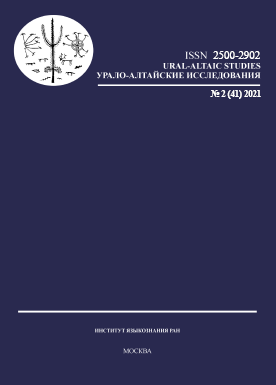ПРИМЕНЕНИЕ МЕТОДИКИ КЛАСТЕРИЗАЦИИ В РЕШЕНИИ ПРОБЛЕМ ДИАЛЕКТНОГО ЧЛЕНЕНИЯ КАРЕЛЬСКОГО ЯЗЫКА (НА ПРИМЕРЕ ДИСТРИБУЦИИ ПЕРЕДНЕЯЗЫЧНЫХ ЩЕЛЕВЫХ СОГЛАСНЫХ)
APPLICATION OF THE CLUSTERING TECHNIQUE TO DIALECT DIVISION OF THE KARELIAN LANGUAGE (CASE STUDY OF THE DISTRIBUTION OF FRONT FRICATIVE CONSONANTS)
Author(s): Irina Petrovna NovakSubject(s): Historical Geography, Phonetics / Phonology, Finno-Ugrian studies, Methodology and research technology
Published by: Институт языкознания Российской академии наук
Keywords: Karelian language; dialectology; linguistic geography; dialect division; cluster analysis; cognate analysis;
Summary/Abstract: The need has arisen to revise the dialect division of the Karelian language using modern methods for processing big data. This article examines how this task can be handled using the cluster analysis algorithm through the case study of one of the most vivid phonetic markers of Karelian dialectal speech — the distribution of front fricative consonants, which depends on a variety of factors working individually or together in different proportions: position of the consonant in the word, front or back vocalism of the word, presence of the vowel i in the immediate vicinity, etc. The source material for the study was digitalized and coded dialectal data from “Programs for collecting material for the dialectal atlas of the Karelian language” (approx. 37 500 units) filled out in 1937—1950 in 146 settlements in Karelia. Mapping of the clustering output visualizes the formation history of Karelian supradialects and dialects, and enables a more precise drawing of certain isoglosses of the phonetic phenomenon in question. The results of the cluster analysis were verified by comparing against the data derived by processing the same dialectal material with the Cognate analysis tool of the LingvoDoc linguistic platform, and against the conclusions based on traditional linguistic geography methods as published by D. Bubrikh and P. Virtaranta. We can conclude from the study that the suggested technique can be applied as the basis for dealing with dialect division of the Karelian language.
Journal: Урало-алтайские исследования
- Issue Year: 2021
- Issue No: 02 (41)
- Page Range: 103-131
- Page Count: 30
- Language: Russian

